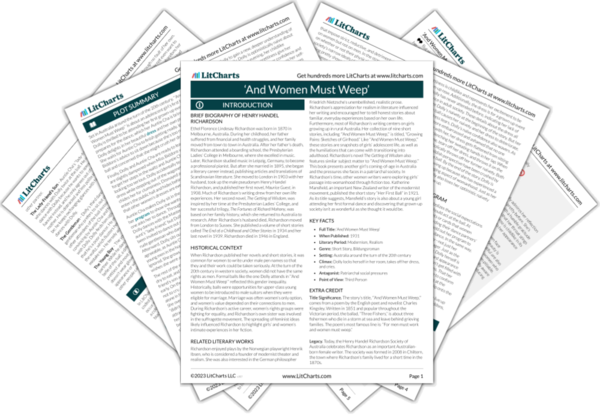“‘And Women Must Weep,’” a story of a young girl’s first ball in Australia around the turn of the 20th century, is fundamentally about an adolescent experience. Dolly’s youthful naivety and innocence shine through her confidence and excitement for the dance. Her enthusiasm reflects her hopes for the opportunities that her entry into the “grown-up” world will bring her. But the ball doesn’t proceed as Dolly wishes, which reflects the difficulties of transitioning into a new stage of life. Throughout the ball, Dolly worries how other people perceive her, sinks into embarrassment and disappointment when few men want to dance with her, and burns with shame for her social failures. She leaves the ball early and isolates herself at home. In the end, Dolly cries, overwhelmed with humiliation. Her optimistic expectations for adulthood did not align with the dismaying reality she has now experienced. Most importantly, Dolly recognizes society’s unfair standards. Even if she tries her best to live up to society’s expectations for her as a young woman, she will not be able to reach them, through no fault of her own. As Dolly comes to understand that she may not even want to conform to society’s expectations, she not only abandons her naivety but also gains deeper self-knowledge than she had before. Although the story takes place within a single evening, Dolly undergoes an internal transformation; she grows up. Through Dolly’s experience of the ball, Richardson portrays the loss of naivety as a central experience of adolescence and suggests that growing up is a painful process of obtaining a new perspective on oneself, the world, and how one relates to society.
Growing Up ThemeTracker

Growing Up Quotes in ‘And Women Must Weep’
But she could not bring herself to sit, for fear of crushing her dress—it was so light, so airy. How glad she felt now that she had chosen muslin, and not silk as Auntie Cha had tried to persuade her. The gossamer-like stuff seemed to float around her as she moved, and the cut of the dress made her look so tall and so different from everyday that she hardly recognised herself in the glass; the girl reflected there—in palest blue, with a wreath of cornflowers in her hair—might have been a stranger.

Unlock explanations and citation info for this and every other ‘And Women Must Weep’ quote.
Plus so much more...
Get LitCharts A+Something hot and stinging came up her throat at this: a kind of gratitude for her pinky-white skin, her big blue eyes and fair curly hair, and pity for those girls who hadn’t got them.
Alas! in getting out a little accident happened. She caught the bottom of one of her flounces—the skirt was made of nothing else—on the iron step, and ripped off the selvedge. Auntie Cha said: “My dear, how clumsy!” She could have cried with vexation.
And now Dolly saw that the hall was full of lovely dresses, some much, much prettier than hers, which suddenly began to seem rather too plain, even a little dowdy; perhaps after all it would have been better to have chosen silk.
Men, looking so splendid in their white shirt fronts, would walk across the floor and seem to be coming […] And then at the last minute they ran away—and it wasn’t her at all, but a girl sitting three seats further on; one who wasn’t even pretty, or her dress either. But her own dress was beginning to get quite tashy, from the way she squeezed her hot hands down in her lap.
And to this she clung, sitting the while wishing with her whole heart that her dress was black and her hair grey, like Auntie Cha’s […] Yes, to-night she wished she was old… an old, old woman.
She wanted only to be quite alone…where nobody could see her…where nobody would ever see her again […] she tore off the wreath and ripped open her dress, now crushed to nothing from so much sitting, and threw them from her anywhere…
Oh, the shame of it!...the sting and the shame. Her first ball, and not to have “taken,” to have failed to “attract the gentlemen”—this was a slur that would rest on her all her life.
And yet…and yet…in spite of everything, a small voice that wouldn’t be silenced kept on saying: “It wasn’t my fault…it wasn’t my fault!”
For really, truly, right deep down in her, she hadn’t wanted “the gentlemen” any more than they’d wanted her: she had only had to pretend to.











